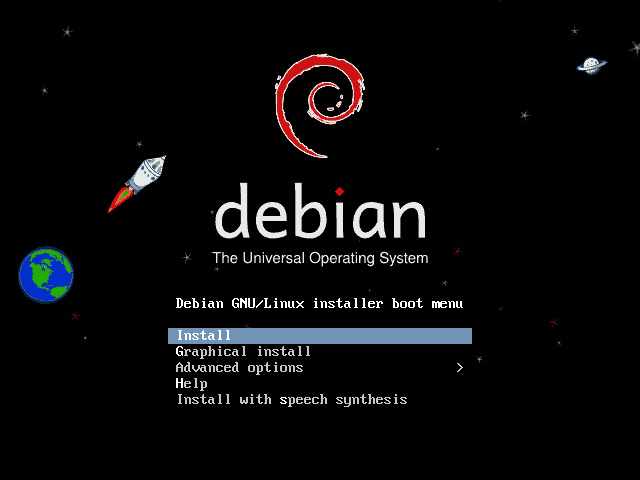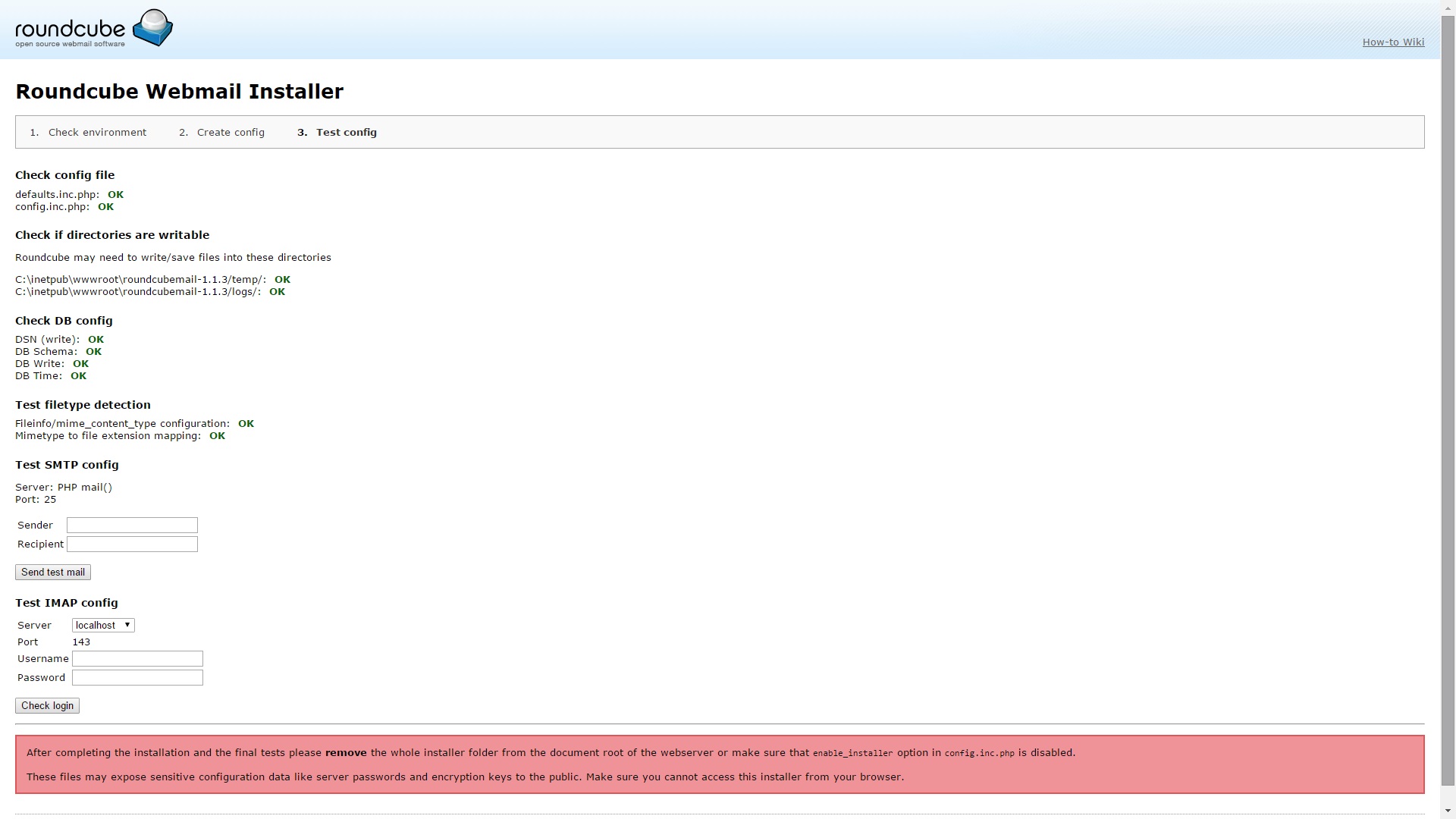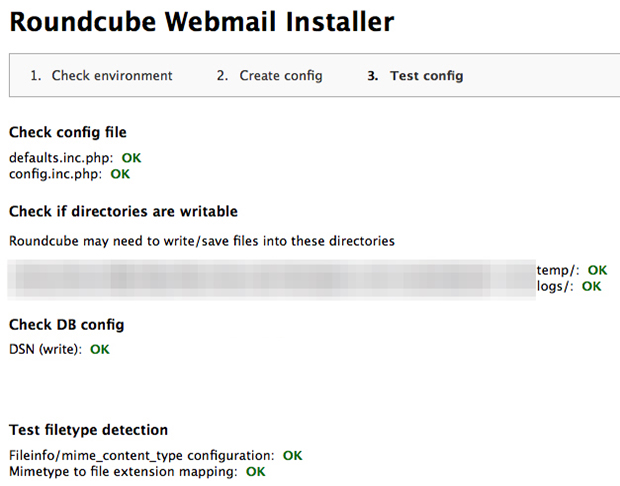Roundcube Webmail Installer
Install RoundCube Webmail for Postfix Mail Server – Part 4. Roundcube is one of such programs, and given its many features (which you can read more about in the project’s website) it is the one we have chosen to use in this tutorial.
- Roundcube can also be installed through auto installers like softaculous.com or cPanel. The BitNami Roundcube Stack provides a one-click installer for various platforms and cloud services. Via the Cloudron app store. Each Cloudron is a fully equipped mail server and has sieve integration.
- Virtualmin Install Scripts Available scripts Email RoundCube. Select the radiobutton of Roundcube and click on “Show Install Options” Click on “Install now” to install webmin. Roundcube Installation on virtualmin will take only few minutes. After roundcube installation you will see the below message.
- How to download and install Roundcube Webmail for Windows 10 PC/laptop. Now let’s just move to the next section to share the steps you have to follow to download Roundcube Webmail for Windows PC. So here we go: Download the Roundcube Webmail installer file from the link above. Save the downloaded file to your computer.
- Roundcube is a modern and customizable IMAP-based webmail client written in PHP. It has a large set of features for viewing, organizing, and composing emails, as well as support for contacts and calendar management. With its plugin repository, you can add functionality comparable to the most popular browser-based clients.
Roundcube is web-based multilingual IMAP client with apps-like user interface which allows you to access all your external mail boxes from a single web interface.. With LAMP / LEMP support, it a great way to bring all your external mails like Google, Yahoo, and other SMTP inboxes onto your own server..
This brief tutorial shows students and new users how to install Roundcube web-mail client on Ubuntu with Apache2, MariaDB and PHP 7.2 support..
Roundcube also comes with decent performance, simple installation and upgrade with support for IMAP and SMTP protocols (SSL, STARTTLS), sieve scripts support, integration with Facebook, Google, Twitter, and Dropbox and many more via plugins..
For more about Roundcube, please check out its homepage…Some highlights of Roundcube:
- Modern user interface.
- Complete support of IMAP and SMTP protocols including SSL and STARTTLS.
- Sieve scripts (Filters and vacation message).
- Minimalistic resources requirements.
- Multilingual capabilities
- Find-as-you-type address book
- Richtext/HTML message composing
- Searching messages and contacts
- Shared folders and ACL

When you’re ready to get Roundcube install on Ubuntu, follow the steps below:
Step 1: Install Apache2 HTTP Server
Apache2 HTTP Server is the most popular web server in use… so install it, since Roundcube needs it.. To install Apache2 HTTP on Ubuntu server, run the commands below…
After installing Apache2, the commands below can be used to stop, start and enable Apache2 service to always start up with the server boots.
To test whether Apache2 is installed, open your browser and browse to the server hostname or IP address… When you see that, then Apache2 is working as expected..
Step 2: Install MariaDB Database Server
MariaDB database server is a great place to start when looking at open source database servers to use with Roundcube… To install MariaDB run the commands below…
sudo apt-get install mariadb-server mariadb-client
After installing MariaDB, the commands below can be used to stop, start and enable MariaDB service to always start up when the server boots..
Run these on Ubuntu 16.04 LTS
Run these on Ubuntu 17.10 and 18.04 LTS
After that, run the commands below to secure MariaDB server by creating a root password and disallowing remote root access.
sudo mysql_secure_installation
When prompted, answer the questions below by following the guide.
- Enter current password for root (enter for none): Just press the Enter
- Set root password? [Y/n]: Y
- New password: Enter password
- Re-enter new password: Repeat password
- Remove anonymous users? [Y/n]: Y
- Disallow root login remotely? [Y/n]: Y
- Remove test database and access to it? [Y/n]: Y
- Reload privilege tables now? [Y/n]: Y
Restart MariaDB server
To test if MariaDB is installed, type the commands below to logon to MariaDB server
sudo mysql -u root -p
Then type the password you created above to sign on… if successful, you should see MariaDB welcome message
Step 2: Install PHP 7.2 and Related Modules
Roundcube Webmail Installation Windows
PHP 7.2 may not be available in Ubuntu default repositories… in order to install it, you will have to get it from third-party repositories.
Run the commands below to add the below third party repository to upgrade to PHP 7.2
Then update and upgrade to PHP 7.2
sudo apt update
Next, run the commands below to install PHP 7.2 and related modules.
sudo apt install php7.2 libapache2-mod-php7.2 php7.2-common php7.2-curl php7.2-mbstring php7.2-xmlrpc php7.2-mysql php7.2-gd php7.2-xml php7.2-intl php7.2-ldap php7.2-imagick php7.2-json php7.2-cli
After installing PHP 7.2, run the commands below to open PHP default config file for Apache2…
Then make the changes on the following lines below in the file and save. The value below is great settings to apply in your environments.

After making the change above, save the file and close out.
Step 3: Restart Apache2
After installing PHP and related modules, all you have to do is restart Apache2 to reload PHP configurations…
To restart Apache2, run the commands below
Roundcube Webmail Installer Test Config
sudo systemctl restart apache2.service
To test PHP 7.2 settings with Apache2, create a phpinfo.php file in Apache2 root directory by running the commands below
sudo nano /var/www/html/phpinfo.php
Then type the content below and save the file.
<?php phpinfo( ); ?>
Save the file.. then browse to your server hostname followed by /phpinfo.php
You should see PHP default test page…
Step 4: Create Roundcube Database
Now that you’ve installed all the packages that are required for Roundcube to function, continue below to start configuring the servers. First run the commands below to create a blank Roundcube database.
To logon to MariaDB database server, run the commands below.
sudo mysql -u root -p
Then create a database called roundcube
CREATE DATABASE roundcube;
Create a database user called roundcubeuser with new password
CREATE USER 'roundcubeuser'@'localhost' IDENTIFIED BY 'new_password_here';
Then grant the user full access to the database.
GRANT ALL ON roundcube.* TO 'roundcubeuser'@'localhost' IDENTIFIED BY 'user_password_here' WITH GRANT OPTION;
Finally, save your changes and exit.
Step 3: Download and Configure Roundcube
Now that Apache2 and PHP 7.2 are installed, use the steps below to download and configure Roundcube environment on Ubuntu servers… First use the commands below to download the latest version…
After that create Roundcube directory and extract the download content there…
After that, run the commands below to import Roundcube database tables to initiate the database…
Next, configure the directory access permission for Apache2…
When you’re done, run the commands below to create Roundcube Apache2 configuration file…
sudo nano /etc/apache2/sites-available/roundcube.conf
Then copy and paste the content below into the file and save…
Save the file and exit.
Next, run the commands below to enable Roundcube virtual host and restart Apache2…
Finally, open your web browser and browse the server name to access the back-end portal…
You should see that all the checks are ok… Click Next to continue with the setup..
Roundcube Webmail Page
On the next page, focus mainly on the Database, IMAP and SMTP sections… The easiest IMAP and SMTP host to use is Google…
Google IMAP settings…
Google SMTP settings…
Finally, check if you can send test email via your logon… if everything successful, you should be able to finish the setup… After that, use the URL below to logon to Roundcube back-end portal..
Run the commands below to delete the installer folder…
sudo rm -rf /var/www/html/roundcube/installer

Login and begin configuring Roundcube
Congratulations! You have successfully installed and configure Roundcube on Ubuntu 16.04 | 18.04 with Apache2 and PHP 7.2.
You may also like the post below:
